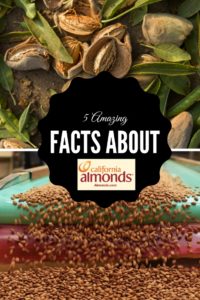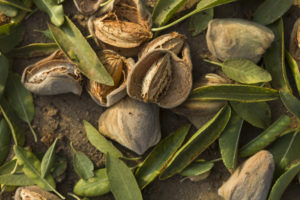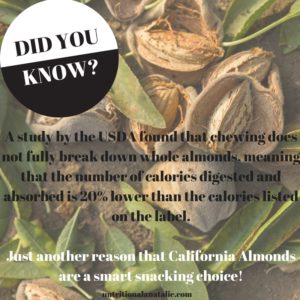Last updated on February 28th, 2021 at 10:23 am
Disclosure: I was provided with free travel and accommodations to the California Almond Orchard experience. I was not additionally compensated for my time.
Think about this question for 30 seconds. Where did the almonds in your pantry come from?
If your answer is Trader Joe’s or the local supermarket, then this post is for you. Up until about two weeks ago, I had not considered much about almonds other than their wonderful nutrient composition. If someone asked me, “What makes almonds good for you?” I would’ve rattled off a list of nutrients, like fiber, protein, healthy fats, Vitamin E and calcium. If someone asked me, “How are they grown?”, my answer would have been, “ummmm…”
Luckily, the California Almond Board sent me on an amazing trip to the almond orchards in Lodi, California, where I was educated in all things almonds, including sustainability, growing methods, almond life cycles and nutrition research. This trip was so educational and interesting that I felt compelled to share what I learned. Plus, I’ve had this awesome almond recipe in the Nutrition à la Natalie recipe vault, and this is the perfect time to share it. Make sure you read all the way through to get the recipe.
5 Amazing Facts About California Almonds:
- Almond varieties. An almond is an almond, right? Wrong! There are actually about 30 different almond varieties produced in California, and 10 of those varieties represent over 70% of production. The different varieties are sorted into groups based on characteristics such as size, shape, and “blanchability” (removal of the skin). Most almonds produced in California are called Nonpareil, California or Mission.
- Bees are vital to almond growth. In recent years, there have been problems with honey bee survival. Since 1995, almond growers have invested more $2.3 million dollars in research to improve honey bee health. The Almond Board also partners with more than 20 organizations to support honey bee health.
- Almonds use the same amount of water as many other crops. In California, almonds have the reputation of using more water than other crops, which is unequivocally false. In the last 20 years. almond growers have worked to improve their water efficiency by 33%.
Growing almonds uses the same amount of water as growing walnuts, pistachios, apples, pears, cherries, citrus and avocados. - The almond life cycle is complex. Almonds grow on trees in November through February. They bloom into beautiful white flowers between February and March. Boxes of bees are placed in the orchards to pollinate the almond blossoms, and each pollinated blossom turns into an almond. From March to June, almonds mature on the tree and the kernel inside and the green fuzzy hull form and the shell hardens. In July and early August, almond hulls dry out and turn from green to brown and begin to split open. Shortly before harvest, the hulls open completely and look like this:
The almonds then dry in the sun before they are swept into rows and picked up by another machine. The almonds then go to a processing facility to have their hulls and shells removed. The hulls are then used as livestock feed, and the shells are used as livestock bedding. The almonds are sorted according to grade and size. Then, they are kept in temperature controlled storage to maintain quality until they are shipped.
5. A nutrition fun fact.
And finally, a recipe video for Almond Crusted Date Balls. What’s your favorite fact from this post? Share it with me on Facebook or Twitter!
Makes 5-6 balls
Ingredients:
¼ cup raw unsalted California Almonds
½ cup of pitted dates
1 tablespoon of peanut butter
¼ teaspoon of sea salt
Directions:
- Place almonds in a food processor and process until finely chopped.
- Place chopped almonds on a hot pan and toast until golden brown. Set aside the almonds.
- Put the dates and peanut butter in the food processor and process until the mixture comes together.
- Add sea salt to the almonds.
- Roll the date and peanut butter mixture into tiny balls. Coat the balls in the almond mixture. Set aside on wax paper. When all the balls are coated, put in the fridge for at least one hour.





Such an informative post! I love almonds, and those date balls look amazing!
Love almonds!!
So informative! makes me love almonds even more!
Love that little nut! And the more I know about them, the more I love them!
Lots of great info here about almond. Yummy recipe 🙂